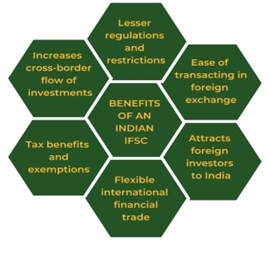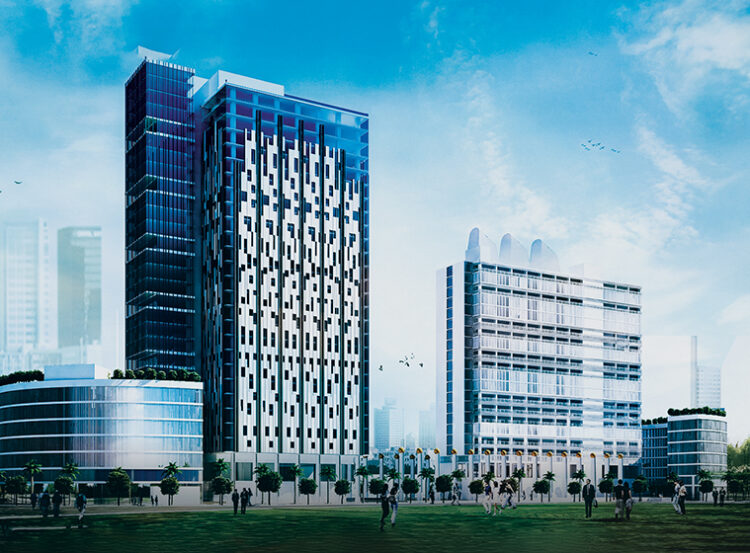As the India seeks to fast track its growth to achieve its place amongst the top three global economies, the efficiency and volume of financial flows become increasingly important. Towards this end, the Government has been taking various initiatives which, though relevant, have not created the desired impact.
It is expected that the step by the Government of India (GoI) to create an International Financial Services Centre (IFSC) would yield better results. Some of the thriving IFSC centres around the world in Singapore, Hong Kong, and Dubai were set up almost 15-20 years ago, though London, New York and others like Luxemburg, have been traditionally providing many of the associated services for much longer.
Under the SEZ Act (2005), IFSCs can be set up as an SEZ or within one. Their main USP is that despite being located on-shore, they are “deemed foreign territory” for most regulatory purposes. This means that many of the local laws, tariffs and other regulations will not apply to IFSCs. A special set of laws is usually designed for these centres for facilitating capital flows without any restrictions. Prior to the establishment of a unified International Financial Service Centre Authority (IFSCA), the domestic financial regulators, namely, RBI, SEBI, PFRDA and IRDA regulated the business in IFSC.
The key benefits expected to accrue from an Indian IFSC, are displayed in the chart below:

Gujarat International Finance Tec-City (GIFT City)
This is India’s first IFSC and is an under-construction central business district in Ahmedabad, Gujarat, India. The Gift City has two zones, GIFT City and the GIFT IFSC. The city is spread across 883 acres and is set to have offices, residences, and all amenities required for the smooth functioning of a metro city. 625 acres are designated as Domestic Tariff Area (DTA), while 261 acres are designated as SEZ area. A total of 62 million square feet of the built-up area would be created, with 67% of that area being commercial space, 22% being residential space, and 11% being social space.
IFSC has two exchanges NSE IFSC and the BSE subsidiary India International Exchange (INX). Built with the idea of creating a financial hub like Singapore in India, GIFT City is being constructed on the banks of the Sabarmati River. The GIFT City offers a wide range of services like capital market transactions, banking services, offshore asset management and other financial transactions. It is intended to serve not only India but the entire world as an integrated hub for financial and technological services.
In her budget for 2021, the Union Finance Minister, Nirmala Sitharaman, emphasized the importance of a high-class fintech hub like Gujarat International Finance Technology City (GIFT City) for boosting national growth. Notably, India has been a growing market for the fintech space with a projected 22.7% CAGR between 2020 to 2025. There are expectations that it would exceed USD 6 billion by 2025, pushing the country’s fintech activities and driving innovation.
The financial hub at GIFT CIty is also expected to assist in creating more than 1.5 lakh jobs for the country’s youth. Moreover, it would also boost designing of Artificial Intelligence (AI) and Machine Learning (ML) applications for enhanced governance and tech-enabled tax functioning.
The other noteworthy features of GIFT City are on the following lines:
- Special framework for ancillary services like accounting, legal, and taxation, among others in line with worldwide peers such as DIFC, Dubai International Financial Center.
- Offering a complete ecosystem for the financial service sector with the ancillary services companies in place.
- Service providers to offer services not only to companies set up in the IFSC but also to financial services firms from foreign jurisdictions for different activities in the Indian IFSCs and other related activities in the global markets.
- Ancillary service firms can also cater to Indian firms who propose to carry out, open, or set up operations in IFSCs or overseas jurisdictions, provided consideration is settled in freely convertible currency.
- The slew of tax incentives declared in the union budget has reaffirmed GoI’s commitment to developing GIFT City IFSC as a global financial hub.
- There are expectations that more than 25,000 smart houses will be built in GIFT City, spread across 833 acres on the banks of the Sabarmati river.
- In the past ten years, 18 to 20% of the proposed greenfield development at GIFT City has been completed. In Phase-I, about 2,000 crore INR is already spent on infrastructure, and the project has attracted over INR 11,000 crore investment.
- In the second phase, GIFT City would spend more than INR 4,000 crore in infrastructure development in a total of 20 mn sq ft.
- In the financial year 2016, Security Transaction Tax, Dividend Distribution Tax, Commodity Transaction Tax, and Long Term Capital Gains were waived or abolished to attract more investments. This was followed by the appointment of a unified regulator for the IFSC. In 2019, further concessions were granted including tax holiday extensions and announcements for aircraft leasing.
- There are applications from half a dozen India-centric Alternative Investment Funds in Singapore, Mauritius and within the country. Moreover, things have paced up after the unified regulator has joined.
- An international bullion exchange is also coming up. The regulation was finalized in December 2020. NSE, BSE, and MCX have since agreed in principle to develop one exchange within GIFT City. The bullion exchange would be set up within the IFSC.
- GIFT City is also setting up a fintech hub that would service the technological requirements of financial institutes such as banks. It is in talks with ADB, Asian Development Bank for the purpose and is already working with iCreate and the Bank of America in this direction.
While the GIFT City is an undoubtedly attractive proposition, several issues have raised questions about the pace of execution and extent of its creation and services range. Some of these are summarized below:
The Indian rupee is not freely convertible – Restrictions exist on certain overseas transactions that are imposed on Indian companies and individuals which reduces the attractiveness of GIFT City.
- Regulatory approvals are still required for some financial products for eg. to operate within the IFSC a broker needs to set up a separate company.
- LRS Scheme not at par –RBI has extended its Liberalised Remittance Scheme (LRS) for entities operating in the IFSC, allowing Indian residents to send up to USD 250,000 abroad in a financial year which is not at par with other developed countries.
- Transactions are not instantaneous– All transactions that are currently deployed in the IFSC are SWIFT transactions and have a settlement period of T+2 days. The central clearing bank to reduce delays to be set up by SBI has still to come up.
- Restrictions on pledging –The Banking Regulation Act does not allow foreign banks to pledge 100% of their shares of Indian companies in case of External Commercial Borrowings (ECBs) and can pledge up to 30% of their holdings only.
- The Gift City project has had a very slow start. From bring first conceived in 2007, land allotment took 4 years. Work started in 2012, business regulations were given in 2015, and an international exchange was established in 2017. However, it was only in 2020 when an IFSCA chairman was appointed.
- During this last decade, the City has registered about 300 entities as of now most of which are proprietary, its investment banking assets stand at USD 30.7 billion and its investments are at USD 1.5 billion, this includes both committed and realized investments. It is yet to have any primary listed company. Many financial institutions, law and consultancy firms have just taken token offices while most of their operations are still being carried out from other centres. About 20 Alternate Investment Funds, licensed by the IFSC, are also yet to start operations.
The GIFT city is an ambitious step taken by GoI to accelerate the country towards new global heights. It, however, is still a work in progress. This ambitious project has witnessed the 2008 subprime crisis, pandemic, as well as the current global turmoil. As countries move towards securing supply chains, minimizing financial interlocking amidst weaponizing of international remittances, escalating sanctions regime, etc., only time will tell how much enthusiasm is still left for financial globalization and IFSCs.








